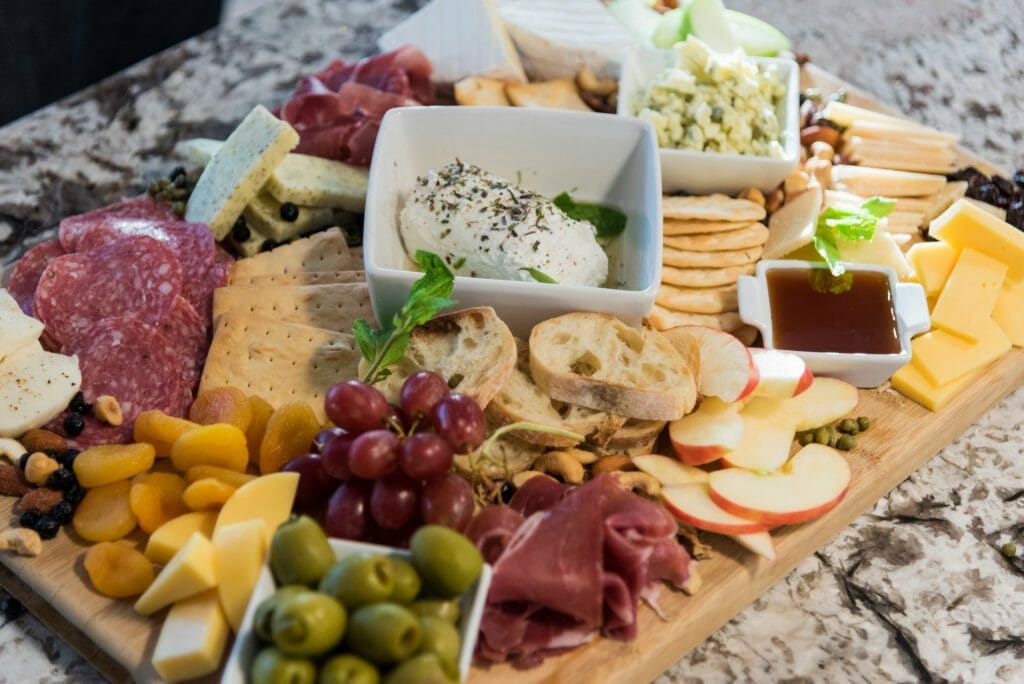If you are thinking of starting your own charcuterie board business the best place to begin is by laying out a simple business plan. Plans like this do not need to be overly complicated and are the foundation of most successful ventures. It's the roadmap that will guide you through the initial stages of your business, from projecting start up costs to determining your target market and creating a marketing strategy. Without a plan, you could be setting yourself up for a rough time and unexpected expenses.
In this article, we'll cover everything you need to know about creating a charcuterie business plan. We'll delve into the key components such as market analysis, financial projections, simple operations and most importantly: where will the sales come from? So, grab a pen and paper, let's get started on building your dream charcuterie business!
TIP: Join us for our free, live training about how to grow and thrive with your charcuterie brand! Click here to read more >>
Table of Contents [CLICK HERE TO OPEN]
Understanding the Charcuterie Industry

The charcuterie industry has come a long way since its humble beginnings in 15th century France. Once a simple way to preserve meats before the advent of refrigeration, charcuterie has evolved into a sophisticated culinary art form, celebrated for its delectable flavors, appealing textures, and stunning visual presentation.
Today, the charcuterie industry is thriving, with a growing number of entrepreneurs recognizing the potential in this niche market. From dedicated charcuterie shops and catering services to online courses and live workshops, the opportunities are as diverse as the ingredients that make up a beautifully crafted board.
Then there's the part about how gorgeous a well-arranged board can be. Charcuterie can really class up an event and get people talking about it for months. The visual appeal of a meticulously curated board not only enhances the dining experience but also serves as a conversation starter, making it an attractive choice for various occasions, from intimate gatherings to lavish celebrations.
Industry Trends & Establishing Your Unique Style
In the ever-evolving world of charcuterie, it's essential to find your niche and establish your own unique style while staying current with industry trends. Your charcuterie business plan should include a section that outlines your signature approach and explains how you'll adapt to and incorporate new trends. Here are some tips to help you stand out and stay relevant in the charcuterie business:
Develop your signature style: Identify what sets your charcuterie boards apart from others. This could be a unique combination of flavors, a specific presentation style, or a commitment to local and artisanal products. Having a distinct signature style will help you build a brand identity and attract loyal customers.
Stay informed: Regularly research industry trends, attend workshops, and follow influential charcuterie experts on social media. This will not only help you stay up-to-date on the latest developments but also provide inspiration for your own creations.
Adapt and innovate: As you keep abreast of the latest trends, consider how they can be incorporated into your signature style. This will demonstrate your commitment to innovation and ensure that your offerings remain fresh and appealing to your target audience.
Showcase your creativity: Use social media and other marketing channels to highlight your unique charcuterie style. Share eye-catching photos, behind-the-scenes glimpses of your creative process, and engaging stories about your journey in the world of charcuterie. This will help you establish your brand's identity and create a loyal following.
By staying current with charcuterie trends and cultivating a unique style, you'll be well-equipped to create a thriving and memorable charcuterie business that sets you apart from the competition.
TIP: Join us for our free, live training about how to grow and thrive with your charcuterie brand! Click here to read more >>
Components of a Charcuterie Business Plan

Executive Summary
This section provides a brief overview of your business, including your mission statement, target market, products, and services. It should be concise and compelling, highlighting the unique value proposition of your business.
Market Analysis
In this section, you should conduct research on the market for charcuterie products in your area. This includes analyzing the competition, identifying customer needs and preferences, and assessing market trends. It's essential to have a deep understanding of your target market to develop effective marketing strategies.
Marketing and Sales Strategies/Go To Market Plan
This section outlines how you plan to promote and sell your products. This includes your branding strategy, pricing strategy, distribution channels, and advertising campaigns. You should also consider how you will leverage social media and other digital marketing channels to reach your target audience.
Financial Projections
This section provides an overview of your expected revenue, expenses, and profits over the next few years. It should include a detailed breakdown of your startup costs, operating expenses, and projected sales. You should also consider factors such as seasonality and market fluctuations when developing your financial projections.
You can read more about required charcuterie board business licensing as well as commercial kitchen rentals.
To help with income projections we have created in depth articles talking about grazing table prices as well as charcuterie board price guide.
Management Structure
This section outlines the organizational structure of your business, including the roles and responsibilities of each team member. It's important to have a clear understanding of who will be responsible for key functions such as production, marketing, and finance.
Pro Tips
When writing each section of your charcuterie business plan, it's important to be clear, concise, and specific. Use data and research to support your claims and provide a realistic assessment of your business's potential. Additionally, consider seeking feedback from industry experts, mentors, and potential investors to refine your plan.
Successful charcuterie business plans often highlight the unique value proposition of the business, such as using locally sourced ingredients or offering unique flavor combinations. For example, a charcuterie business in Portland, Oregon, called Olympia Provisions, has built a successful brand by using high-quality, locally sourced ingredients and offering a wide range of unique products.
Marketing

TIP: Join us for our free, live training about how to grow and thrive with your charcuterie brand! Click here to read more >>
Being successful in the charcuterie industry is about far more than knowing how to create incredible arrangements. You absolutely must have a plan to attract new customers. In fact, with the growing popularity of artisanal meats and cheeses, it's more important than ever for charcuterie businesses to have a strong marketing strategy in place.
To help, you can read more about how to attract more charcuterie customers.
Your Brand
One of the first steps in creating a successful marketing strategy is to establish a strong brand identity. This means developing a clear understanding of what your business stands for and what sets it apart from the competition. To do this, you should consider your target audience, your unique selling proposition, and your company values. Once you have a clear sense of your brand identity, you can begin to create marketing materials that reflect it, such as a logo, website, and social media profiles.
Social Media
Social media is a powerful marketing tool for charcuterie businesses. Platforms like Instagram and Facebook allow you to showcase your products and engage with customers in real-time. To make the most of social media, it's important to post high-quality photos and videos of your products, use relevant hashtags, and engage with your followers by responding to comments and messages.
Events & Collaborations
Another effective marketing strategy for charcuterie businesses is to participate in events and collaborations. This could include hosting a tasting event at your shop, partnering with a local restaurant to feature your products on their menu, or participating in a food festival or farmers' market. These types of events provide opportunities to connect with new customers and showcase your products in a fun and engaging way.
In summary, marketing is a crucial component of any successful charcuterie business. By establishing a strong brand identity, leveraging social media, and participating in events and collaborations, you can attract new customers, increase sales, and build brand awareness. With the right marketing strategy in place, your charcuterie business can thrive in today's competitive marketplace.
Challenges and Risks of Starting a Charcuterie Business

Starting a charcuterie business can be a fulfilling and rewarding venture, but it's not without its challenges and risks. Not to worry; here we'll prepare you with the most common risk factors and how to overcome them.
Safety Regulations
One of the biggest challenges is navigating the complex web of food safety regulations. As a food-based business, you'll need to comply with local, state, and federal regulations that dictate everything from how you prepare and store your meats to how you label and package your products. Failure to comply with these regulations can result in fines, legal action, and even the closure of your business.
Competition
Another challenge is competition. Charcuterie has become increasingly popular in recent years, and there are likely to be other businesses in your area offering similar products. To stand out from the crowd, you'll need to find a way to differentiate yourself, whether it's through unique flavor combinations, high-quality ingredients, or exceptional customer service.
Financial Risks
Finally, there are financial risks to consider. While starting a charcuterie business does not have to be expensive, there are some costs involved. You'll want to keep in mind costs for equipment, ingredients, assistants, website development and marketing. There's also the risk that your business may not be profitable, especially in the early stages when you're still building your customer base.
TIP: Join us for our free, live training about how to grow and thrive with your charcuterie brand! Click here to read more >>
So how can you mitigate these risks and overcome these challenges?
The key is to do your research and be prepared. Before launching your business, make sure you understand all the relevant food safety regulations and have a plan in place to comply with them. Consider working with a food safety consultant or taking a food safety course to ensure you're up to speed on the latest regulations.
To stand out from the competition, focus on creating a unique and memorable brand that resonates with your target audience. This could include developing a signature flavor or product, offering exceptional customer service, or partnering with local businesses or events to increase your visibility.
Finally, be realistic about your financial projections and have a solid business plan in place. This should include a detailed budget, sales projections, and contingency plans in case things don't go as planned. Consider seeking out funding options, such as loans or grants, to help cover startup costs and ensure you have enough capital to weather any unexpected challenges.
By being prepared and proactive, you can minimize the risks and challenges of starting a charcuterie business and increase your chances of success.
Wrapping It Up

In conclusion, starting a charcuterie business can be a profitable and fulfilling venture for those who are passionate about food and entrepreneurship. To succeed in this industry, it is essential to have a clear understanding of the market, target audience, and competition. Creating a comprehensive charcuterie business plan that includes a marketing strategy, financial projections, and operational details is crucial to ensure the success of your business.
We encourage readers who are interested in starting a charcuterie business to join us for our FREE, LIVE charcuterie business training. Click here to learn more. By doing so, you can avoid common pitfalls and increase your chances of having delicious success.
And of course, think about joining the International Charcuterie Association. We are the single best spot to find all the info you need about the world of grazing!
For more help, check out How To Start A Successful Charcuterie Board Business (2023).







